Hydrothermal Conditions in Deep Soil Layer Regulate the Interannual Change in Gross Primary Productivity in the Qilian Mountains Area, China
Abstract
:1. Introduction
2. Materials and Methods
2.1. Study Area
2.2. Data Sources
2.2.1. MODIS GPP
2.2.2. ERA5-Land
2.2.3. Vegetation Map of China
2.3. Methods
2.3.1. Sen-MK Trend Test
2.3.2. Correlation Analysis
2.3.3. Feature Importance Extraction
3. Results
3.1. Interannual Variation Trends
3.2. Correlation Comparative Analysis
3.3. Feature Importance Extraction
4. Discussion
4.1. Uncertainty Validation
4.2. Interannual Fluctuation Trends
4.3. Influence Degree Threshold Analyses
5. Conclusions
- (1)
- Deeper soil is wetter than shallower soil, proving that the deep soil possesses stronger water retention characteristics than other profiles. Conversely, the interannual variations in soil temperature do not exhibit significant divergence with soil depth. Moreover, the deep soil moisture demonstrates a distinct and significant interannual increasing trend, while soil temperature values show a similar fluctuating upward trend across three soil layers. GPP values exhibit a spatial distribution pattern characterized by low values in the northwest and high values in the southeast. Furthermore, GPP values generally demonstrate a significant increasing trend throughout the study period, confirming the persistent vegetation carbon sequestration capacity of the semi-arid region.
- (2)
- The correlation analyses have confirmed that GPP values exhibit a stronger correlation with deep soil moisture, while the correlations with soil temperature do not show significant differentiation across layers. This pattern is consistently observed in different dominant vegetation areas. Additionally, the magnitude of the PCCs between GPP values and soil moisture of the same layer aligns with the vegetation cover area occupancy.
- (3)
- The Random Forest feature importance extraction provides evidence that the prominent feature variables influencing GPP are the deep soil moisture and the surface soil temperature. These results suggest that soil temperature may exert a non-linear influence on GPP while also confirming the stronger correlation between deep soil moisture and GPP.
Author Contributions
Funding
Data Availability Statement
Conflicts of Interest
References
- Dusenge, M.E.; Duarte, A.G.; Way, D.A. Plant carbon metabolism and climate change: Elevated CO2 and temperature impacts on photosynthesis, photorespiration and respiration. New Phytol. 2019, 221, 32–49. [Google Scholar] [CrossRef]
- Fu, Z.T.; Wu, Q.B.; Wang, L.Y.; Liu, Y.L. Response of soil hydrothermal processes within the active layer to variable alpine vegetation conditions on the Qinghai-Tibet Plateau. Adv. Clim. Chang. Res. 2023, 14, 200–212. [Google Scholar] [CrossRef]
- Zandalinas, S.I.; Mittler, R.; Balfagon, D.; Arbona, V.; Gomez-Cadenas, A. Plant adaptations to the combination of drought and high temperatures. Physiol. Plant. 2018, 162, 2–12. [Google Scholar] [CrossRef]
- Franks, P.J.; Farquhar, G.D. The mechanical diversity of stomata and its significance in gas-exchange control. Plant Physiol. 2007, 143, 78–87. [Google Scholar] [CrossRef] [PubMed]
- Lawson, T.; Matthews, J. Guard cell metabolism and stomatal function. Annu. Rev. Plant Biol. 2020, 71, 273–302. [Google Scholar] [CrossRef] [PubMed]
- Chai, Q.; Wang, T.; Di, C. Evaluating the impacts of environmental factors on soil moisture temporal dynamics at different time scales. J. Water Clim. Chang. 2021, 12, 420–432. [Google Scholar] [CrossRef]
- Hasanuzzaman, M.; Nahar, K.; Alam, M.M.; Roychowdhury, R.; Fujita, M. Physiological, biochemical, and molecular mechanisms of heat stress tolerance in plants. Int. J. Mol. Sci. 2013, 14, 9643–9684. [Google Scholar] [CrossRef]
- Xu, H.J.; Wang, X.P.; Yang, T.B. Trend shifts in satellite-derived vegetation growth in Central Eurasia, 1982–2013. Sci. Total Environ. 2017, 579, 1658–1674. [Google Scholar] [CrossRef]
- Piao, S.; Nan, H.; Huntingford, C.; Ciais, P.; Friedlingstein, P.; Sitch, S.; Peng, S.; Ahlstrom, A.; Canadell, J.G.; Cong, N.; et al. Evidence for a weakening relationship between interannual temperature variability and northern vegetation activity. Nat. Commun. 2014, 5, 5018. [Google Scholar] [CrossRef]
- Tai, X.; Epstein, H.E.; Li, B. Elevation and climate effects on vegetation greenness in an arid mountain-basin system of Central Asia. Remote Sens. 2020, 12, 1665. [Google Scholar] [CrossRef]
- Wang, H.; Liu, X.; Zhang, X.; Wang, P.; Lin, H.; Yu, L. Spatiotemporal crop NDVI responses to climatic factors in mainland China. Int. J. Remote Sens. 2019, 40, 89–103. [Google Scholar] [CrossRef]
- Xing, X.; Qian, J.; Chen, X.; Chen, C.; Sun, J.; Wei, S.; Yimamaidi, D.; Zhanar, Z. Analysis of effects of recent changes in hydrothermal conditions on vegetation in Central Asia. Land 2022, 11, 327. [Google Scholar] [CrossRef]
- Vicente-Serrano, S.M.; Gouveia, C.; Julio Camarero, J.; Begueria, S.; Trigo, R.; Lopez-Moreno, J.I.; Azorin-Molina, C.; Pasho, E.; Lorenzo-Lacruz, J.; Revuelto, J.; et al. Response of vegetation to drought time-scales across global land biomes. Proc. Natl. Acad. Sci. USA 2013, 110, 52–57. [Google Scholar] [CrossRef] [PubMed]
- Nemani, R.R.; Keeling, C.D.; Hashimoto, H.; Jolly, W.M.; Piper, S.C.; Tucker, C.J.; Myneni, R.B.; Running, S.W. Climate-driven increases in global terrestrial net primary production from 1982 to 1999. Science 2003, 300, 1560–1563. [Google Scholar] [CrossRef] [PubMed]
- Wang, Y.; Xiao, J.; Ma, Y.; Luo, Y.; Hu, Z.; Li, F.; Li, Y.; Gu, L.; Li, Z.; Yuan, L. Carbon fluxes and environmental controls across different alpine grassland types on the Tibetan Plateau. Agric. For. Meteorol. 2021, 311, 108694. [Google Scholar] [CrossRef]
- Fu, G.; Shen, Z.X. Environmental humidity regulates effects of experimental warming on vegetation index and biomass production in an alpine meadow of the Northern Tibet. PLoS ONE 2016, 11, e0165643. [Google Scholar] [CrossRef] [PubMed]
- Cui, X.; Xu, G.; He, X.; Luo, D. Influences of seasonal soil moisture and temperature on vegetation phenology in the Qilian Mountains. Remote Sens. 2022, 14, 3645. [Google Scholar] [CrossRef]
- Zhu, J.; Li, H.; He, H.; Zhang, F.; Yang, Y.; Li, Y. Interannual characteristics and driving mechanism of CO2 fluxes during the growing season in an alpine wetland ecosystem at the southern foot of the Qilian Mountains. Front. Plant Sci. 2022, 13, 1013812. [Google Scholar] [CrossRef]
- Liu, L.; Gudmundsson, L.; Hauser, M.; Qin, D.; Li, S.; Seneviratne, S.I. Soil moisture dominates dryness stress on ecosystem production globally. Nat. Commun. 2020, 11, 4892. [Google Scholar] [CrossRef]
- Mishra, V.; Ellenburg, W.L.; Markert, K.N.; Limaye, A.S. Performance evaluation of soil moisture profile estimation through entropy-based and exponential filter models. Hydrol. Sci. J. 2020, 65, 1036–1048. [Google Scholar] [CrossRef]
- Xiao, C.; Ji, Q.Y.; Zhang, F.C.; Li, Y.; Fan, J.L.; Hou, X.H.; Yan, F.L.; Liu, X.Q.; Gong, K.Y. Effects of various soil water potential thresholds for drip irrigation on soil salinity, seed cotton yield and water productivity of cotton in northwest China. Agric. Water Manag. 2023, 279, 108172. [Google Scholar] [CrossRef]
- Wang, Y.; Liu, X.; Lv, M.; Zhang, Z. Mechanisms and influencing factors of hydrothermal processes in active layer soils on the Qinghai-Tibet Plateau under freeze-thaw action. Catena 2023, 220, 106694. [Google Scholar] [CrossRef]
- He, P.; Zeng, Y.; Wang, N.; Han, Z.; Meng, X.; Dong, T.; Ma, X.; Ma, S.; Ma, J.; Sun, Z. Early evidence that soil dryness causes widespread decline in grassland productivity in China. Land 2023, 12, 484. [Google Scholar] [CrossRef]
- Bai, X.; Zhang, L.; He, C.; Zhu, Y. Estimating regional soil moisture distribution based on NDVI and land surface temperature time series data in the upstream of the Heihe River watershed, Northwest China. Remote Sens. 2020, 12, 2414. [Google Scholar] [CrossRef]
- Chen, T.; Xu, H.J.; Qi, X.L.; Shan, S.Y.; Chen, S.Y.; Deng, Y.F. Temporal dynamics of satellite-derived vegetation pattern and growth in an arid inland river basin, Tibetan Plateau. Glob. Ecol. Conserv. 2022, 38, e02262. [Google Scholar] [CrossRef]
- Chang, X.; Xing, Y.; Gong, W.; Yang, C.; Guo, Z.; Wang, D.; Wang, J.; Yang, H.; Xue, G.; Yang, S. Evaluating gross primary productivity over 9 ChinaFlux sites based on random forest regression models, remote sensing, and eddy covariance data. Sci. Total Environ. 2023, 875, 162601. [Google Scholar] [CrossRef]
- Muñoz-Sabater, J.; Dutra, E.; Agustí-Panareda, A.; Albergel, C.; Arduini, G.; Balsamo, G.; Boussetta, S.; Choulga, M.; Harrigan, S.; Hersbach, H. ERA5-Land: A state-of-the-art global reanalysis dataset for land applications. Earth Syst. Sci. Data 2021, 13, 4349–4383. [Google Scholar] [CrossRef]
- Liu, L.; Song, W.; Zhang, Y.; Han, Z.; Li, H.; Yang, D.; Wang, Z.; Huang, Q. Zoning of ecological restoration in the Qilian Mountain area, China. Int. J. Environ. Res. Public Health 2021, 18, 12417. [Google Scholar] [CrossRef]
- Du, J.; He, Z.; Yang, J.; Chen, L.; Zhu, X. Detecting the effects of climate change on canopy phenology in coniferous forests in semi-arid mountain regions of China. Int. J. Remote Sens. 2014, 35, 6490–6507. [Google Scholar] [CrossRef]
- Ma, Y.; Guan, Q.; Sun, Y.; Zhang, J.; Yang, L.; Yang, E.; Li, H.; Du, Q. Three-dimensional dynamic characteristics of vegetation and its response to climatic factors in the Qilian Mountains. Catena 2022, 208, 105694. [Google Scholar] [CrossRef]
- Turner, D.P.; Ritts, W.D.; Cohen, W.B.; Gower, S.T.; Running, S.W.; Zhao, M.; Costa, M.H.; Kirschbaum, A.A.; Ham, J.M.; Saleska, S.R. Evaluation of MODIS NPP and GPP products across multiple biomes. Remote Sens. Environ. 2006, 102, 282–292. [Google Scholar] [CrossRef]
- Cai, Z.; Junttila, S.; Holst, J.; Jin, H.; Ardo, J.; Ibrom, A.; Peichl, M.; Molder, M.; Jonsson, P.; Rinne, J.; et al. Modelling daily gross primary productivity with Sentinel-2 data in the nordic region-comparison with data from MODIS. Remote Sens. 2021, 13, 469. [Google Scholar] [CrossRef]
- Zha, X.; Xiong, L.; Liu, C.; Shu, P.; Xiong, B. Identification and evaluation of soil moisture flash drought by a nonstationary framework considering climate and land cover changes. Sci. Total Environ. 2023, 856, 158953. [Google Scholar] [CrossRef] [PubMed]
- Zhang, X. Vegetation Map of the People’s Republic of China (1:1,000,000); Geology Press: Beijing, China, 2007. [Google Scholar]
- Baniya, B.; Tang, Q.; Huang, Z.; Sun, S.; Techato, K. Spatial and temporal variation of NDVI in response to climate change and the implication for carbon dynamics in Nepal. Forests 2018, 9, 329. [Google Scholar] [CrossRef]
- Sen, P.K. Estimates of the regression coefficient based on Kendall’s tau. J. Am. Stat. Assoc. 1968, 63, 1379–1389. [Google Scholar] [CrossRef]
- Kendall, M.G. Rank Correlation Methods; Charles Griffin: London, UK, 1975. [Google Scholar]
- Pearson, K. On the criterion that a given system of deviations from the probable in the case of a correlated system of variables is such that it can be reasonably supposed to have arisen from random sampling. Lond. Edinb. Dublin Philos. Mag. J. Sci. 1900, 50, 157–175. [Google Scholar] [CrossRef]
- Scornet, E.; Biau, G.; Vert, J.-P. Consistency of random forests. Ann. Stat. 2015, 43, 1716–1741. [Google Scholar] [CrossRef]
- Georganos, S.; Grippa, T.; Vanhuysse, S.; Lennert, M.; Shimoni, M.; Kalogirou, S.; Wolff, E. Less is more: Optimizing classification performance through feature selection in a very-high-resolution remote sensing object-based urban application. GIScience Remote Sens. 2018, 55, 221–242. [Google Scholar] [CrossRef]
- Badih, G.; Pierre, M.; Laurent, B. Assessing variable importance in clustering: A new method based on unsupervised binary decision trees. Comput. Stat. 2019, 34, 301–321. [Google Scholar] [CrossRef]
- He, Y.; Jiang, X.; Wang, N.; Zhang, S.; Ning, T.; Zhao, Y.; Hu, Y. Changes in mountainous runoff in three inland river basins in the arid Hexi Corridor, China, and its influencing factors. Sustain. Cities Soc. 2019, 50, 101703. [Google Scholar] [CrossRef]
- Hao, W.; Li, B.; Xia, B.; Xu, M. Deep carbon dioxide flows substantially contributes to soil-atmosphere carbon flux from Robinia pseudoacacia forests. Ecol. Indic. 2022, 141, 109062. [Google Scholar] [CrossRef]
- Vogel, M.M.; Orth, R.; Cheruy, F.; Hagemann, S.; Lorenz, R.; van den Hurk, B.J.J.M.; Seneviratne, S.I. Regional amplification of projected changes in extreme temperatures strongly controlled by soil moisture-temperature feedbacks. Geophys. Res. Lett. 2017, 44, 1511–1519. [Google Scholar] [CrossRef]
- Zhu, X.; He, Z.; Du, J.; Chen, L.; Lin, P.; Tian, Q. Soil moisture temporal stability and spatio-temporal variability about a typical subalpine ecosystem in northwestern China. Hydrol. Process. 2020, 34, 2401–2417. [Google Scholar] [CrossRef]
- Liu, Y.; Liu, X.; Zhao, C.; Wang, H.; Zang, F. The trade-offs and synergies of the ecological-production-living functions of grassland in the Qilian mountains by ecological priority. J. Environ. Manag. 2023, 327, 116883. [Google Scholar] [CrossRef]
- Zhang, Y.; Kong, D.; Gan, R.; Chiew, F.H.S.; McVicar, T.R.; Zhang, Q.; Yang, Y. Coupled estimation of 500 m and 8-day resolution global evapotranspiration and gross primary production in 2002–2017. Remote Sens. Environ. 2019, 222, 165–182. [Google Scholar] [CrossRef]
- Zheng, Y.; Zhang, L.; Xiao, J.; Yuan, W.; Yan, M.; Li, T.; Zhang, Z. Sources of uncertainty in gross primary productivity simulated by light use efficiency models: Model structure, parameters, input data, and spatial resolution. Agric. For. Meteorol. 2018, 263, 242–257. [Google Scholar] [CrossRef]
- Xing, Z.; Fan, L.; Zhao, L.; De Lannoy, G.; Frappart, F.; Peng, J.; Li, X.; Zeng, J.; Al-Yaari, A.; Yang, K.; et al. A first assessment of satellite and reanalysis estimates of surface and root-zone soil moisture over the permafrost region of Qinghai-Tibet Plateau. Remote Sens. Environ. 2021, 265, 112666. [Google Scholar] [CrossRef]
- Chen, R.; Yang, M.; Wang, X.; Wan, G.; Li, H. Thermal regime variations of the uppermost soil layer in the central Tibetan Plateau. Catena 2022, 213, 106224. [Google Scholar] [CrossRef]
- Cheadle, C.; Vawter, M.P.; Freed, W.J.; Becker, K.G. Analysis of microarray data using Z score transformation. J. Mol. Diagn. 2003, 5, 73–81. [Google Scholar] [CrossRef]
- Liang, L.; Wang, Q.; Guan, Q.; Du, Q.; Sun, Y.; Ni, F.; Lv, S.; Shan, Y. Assessing vegetation restoration prospects under different environmental elements in cold and arid mountainous region of China. Catena 2023, 226, 107055. [Google Scholar] [CrossRef]
- Zhang, J.; Gou, X.; Manzanedo, R.D.; Zhang, F.; Pederson, N. Cambial phenology and xylogenesis of Juniperus przewalskii over a climatic gradient is influenced by both temperature and drought. Agric. For. Meteorol. 2018, 260, 165–175. [Google Scholar] [CrossRef]
- Wu, J.; Sheng, Y.; Wu, Q.; Wen, Z. Processes and modes of permafrost degradation on the Qinghai-Tibet Plateau. Sci. China-Earth Sci. 2010, 53, 150–158. [Google Scholar] [CrossRef]
- Wang, Q.; Yang, Q.; Guo, H.; Xiao, X.; Jin, H.; Li, L.; Zhang, T.; Wu, Q. Hydrothermal variations in soils resulting from the freezing and thawing processes in the active layer of an alpine grassland in the Qilian Mountains, northeastern Tibetan Plateau. Theor. Appl. Climatol. 2019, 136, 929–941. [Google Scholar] [CrossRef]
- Fu, Q.; Hou, R.; Li, T.; Wang, M.; Yan, J. The functions of soil water and heat transfer to the environment and associated response mechanisms under different snow cover conditions. Geoderma 2018, 325, 9–17. [Google Scholar] [CrossRef]
- Matsumura, S.; Yamazaki, K. A longer climate memory carried by soil freeze-thaw processes in Siberia. Environ. Res. Lett. 2012, 7, 045402. [Google Scholar] [CrossRef]
- Tan, B.; Wu, F.Z.; Yang, W.Q.; He, X.H. Snow removal alters soil microbial biomass and enzyme activity in a Tibetan alpine forest. Appl. Soil Ecol. 2014, 76, 34–41. [Google Scholar] [CrossRef]
- Zheng, C.; Tang, X.; Gu, Q.; Wang, T.; Wei, J.; Song, L.; Ma, M. Climatic anomaly and its impact on vegetation phenology, carbon sequestration and water-use efficiency at a humid temperate forest. J. Hydrol. 2018, 565, 150–159. [Google Scholar] [CrossRef]
- Chen, L.F.; He, Z.B.; Zhu, X.; Du, J.; Yang, J.J.; Li, J. Impacts of afforestation on plant diversity, soil properties, and soil organic carbon storage in a semi-arid grassland of northwestern China. Catena 2016, 147, 300–307. [Google Scholar] [CrossRef]
- Sun, W.; Song, X.; Mu, X.; Gao, P.; Wang, F.; Zhao, G. Spatiotemporal vegetation cover variations associated with climate change and ecological restoration in the Loess Plateau. Agric. For. Meteorol. 2015, 209, 87–99. [Google Scholar] [CrossRef]
- Lundberg, S.M.; Erion, G.; Chen, H.; DeGrave, A.; Prutkin, J.M.; Nair, B.; Katz, R.; Himmelfarb, J.; Bansal, N.; Lee, S.-I. From local explanations to global understanding with explainable AI for trees. Nat. Mach. Intell. 2020, 2, 56–67. [Google Scholar] [CrossRef]
- Park, J.; Lee, W.H.; Kim, K.T.; Park, C.Y.; Lee, S.; Heo, T.-Y. Interpretation of ensemble learning to predict water quality using explainable artificial intelligence. Sci. Total Environ. 2022, 832, 155070. [Google Scholar] [CrossRef] [PubMed]
- Chang, I.; Park, H.; Hong, E.; Lee, J.; Kwon, N. Predicting effects of built environment on fatal pedestrian accidents at location-specific level: Application of XGBoost and SHAP. Accid. Anal. Prev. 2022, 166, 106545. [Google Scholar] [CrossRef] [PubMed]
- Yang, Y.; Yuan, Y.; Han, Z.; Liu, G. Interpretability analysis for thermal sensation machine learning models: An exploration based on the SHAP approach. Indoor Air 2022, 32, e12984. [Google Scholar] [CrossRef] [PubMed]
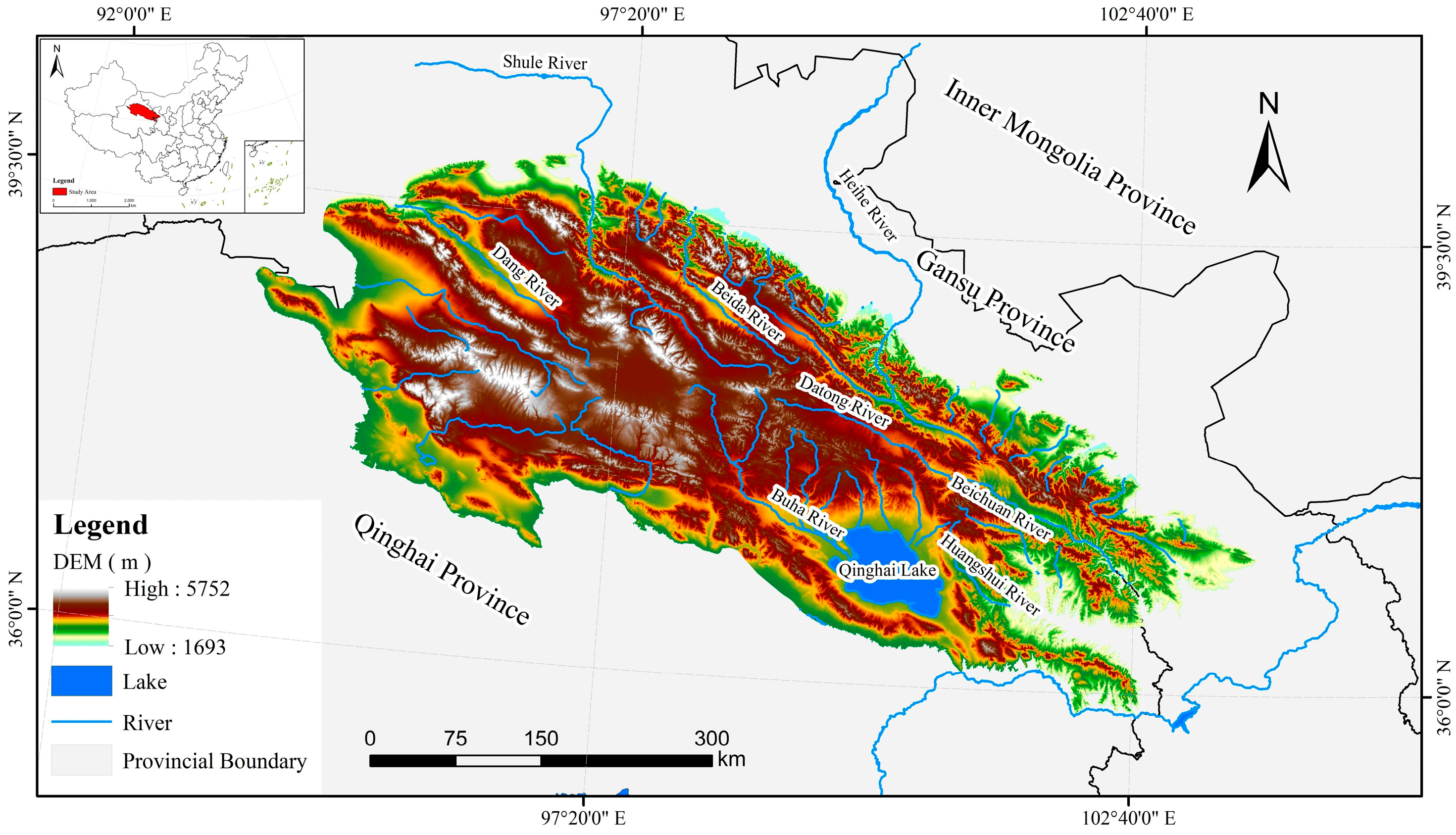
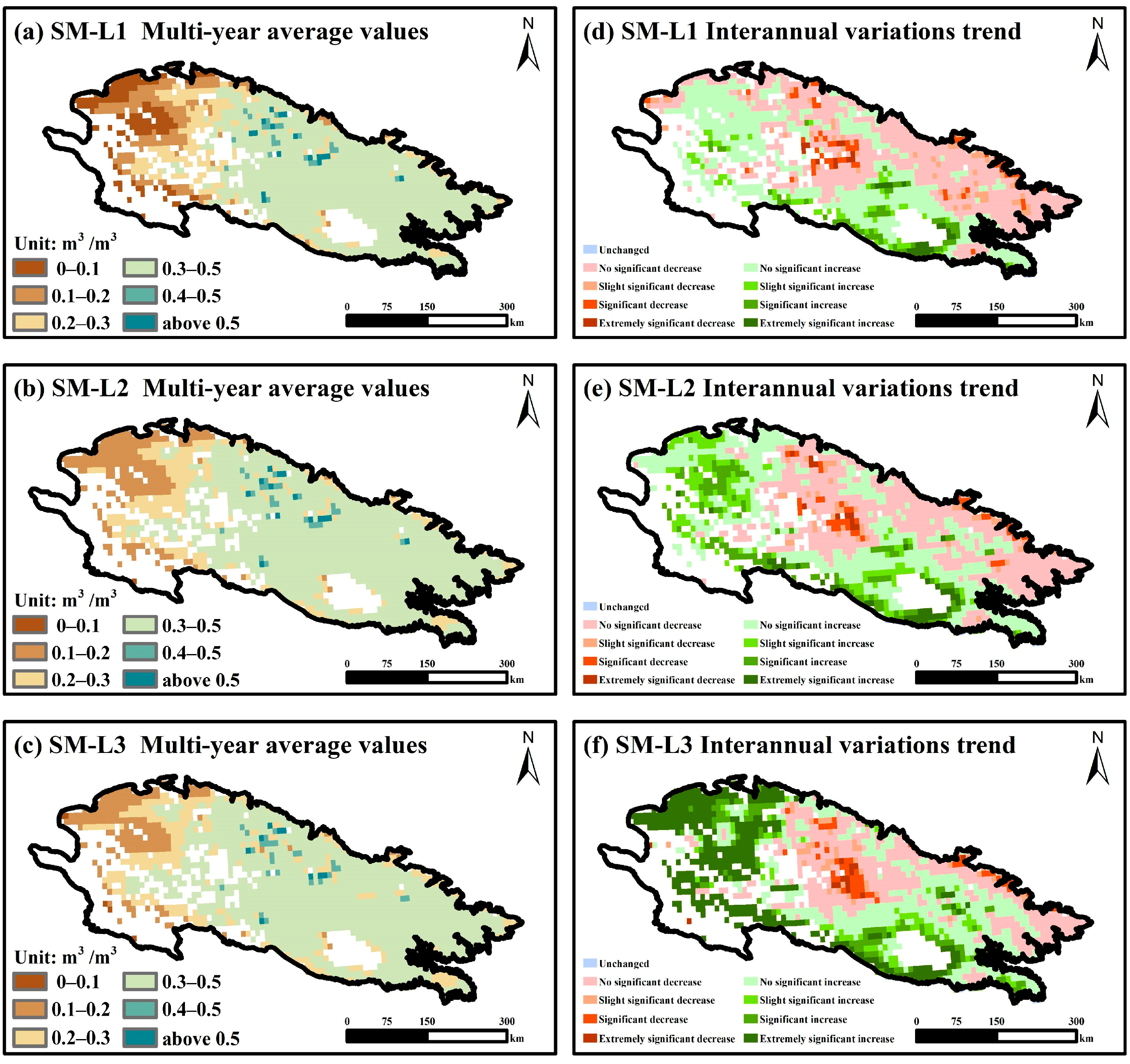




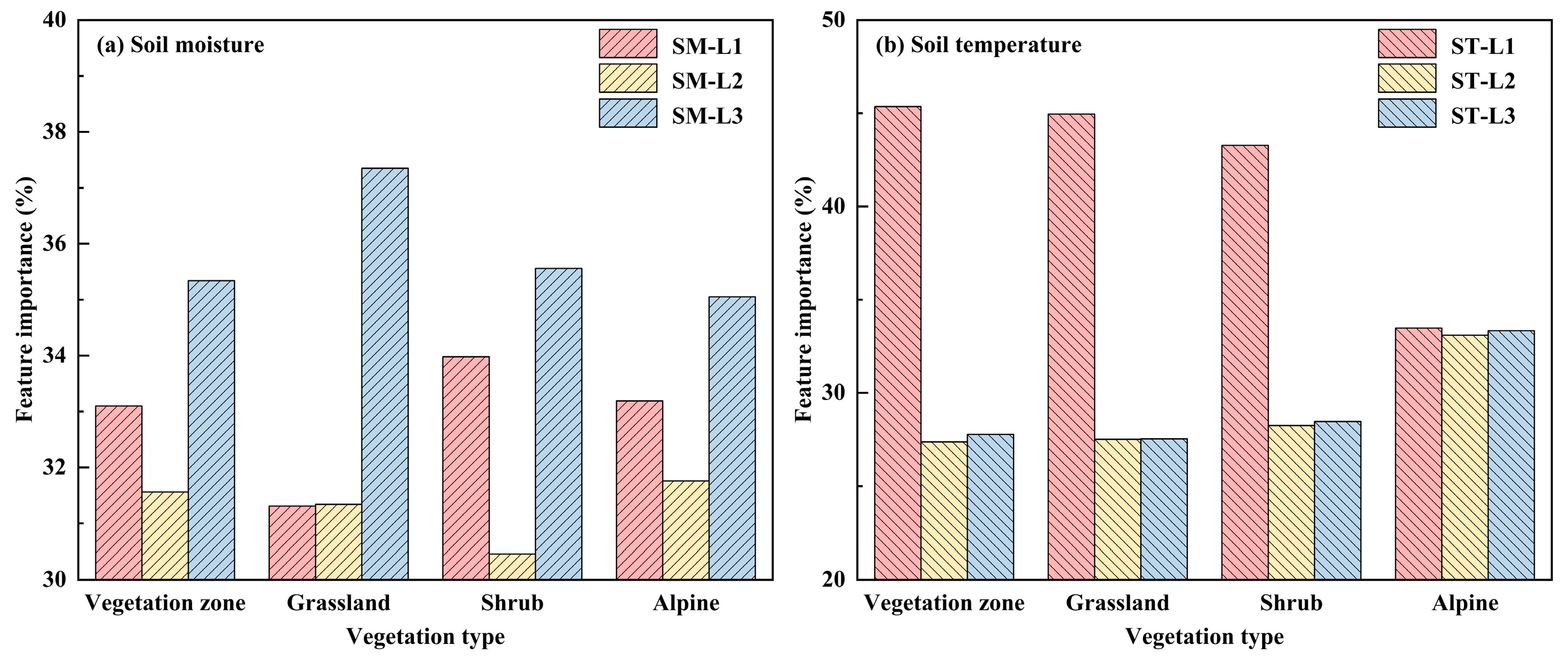

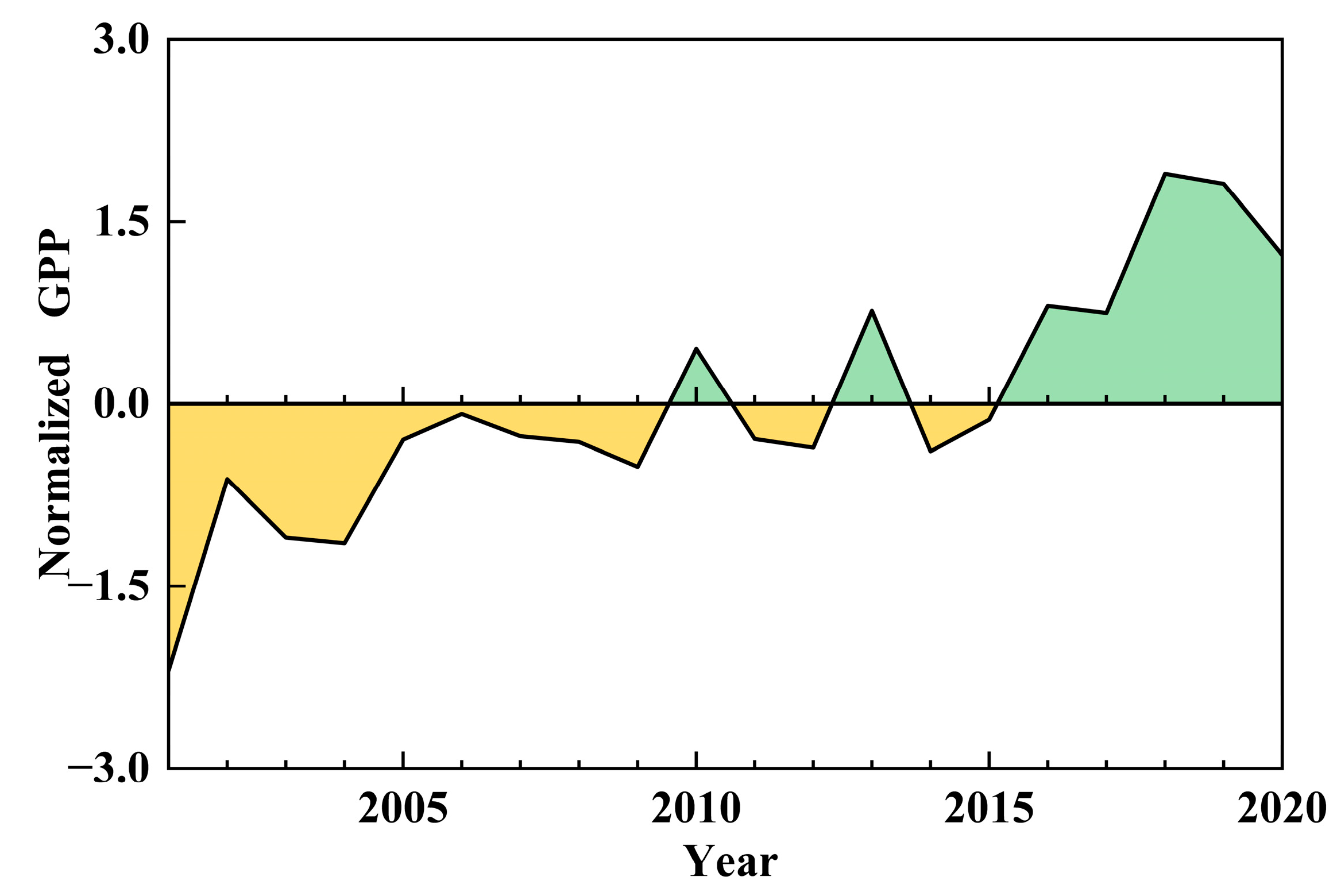
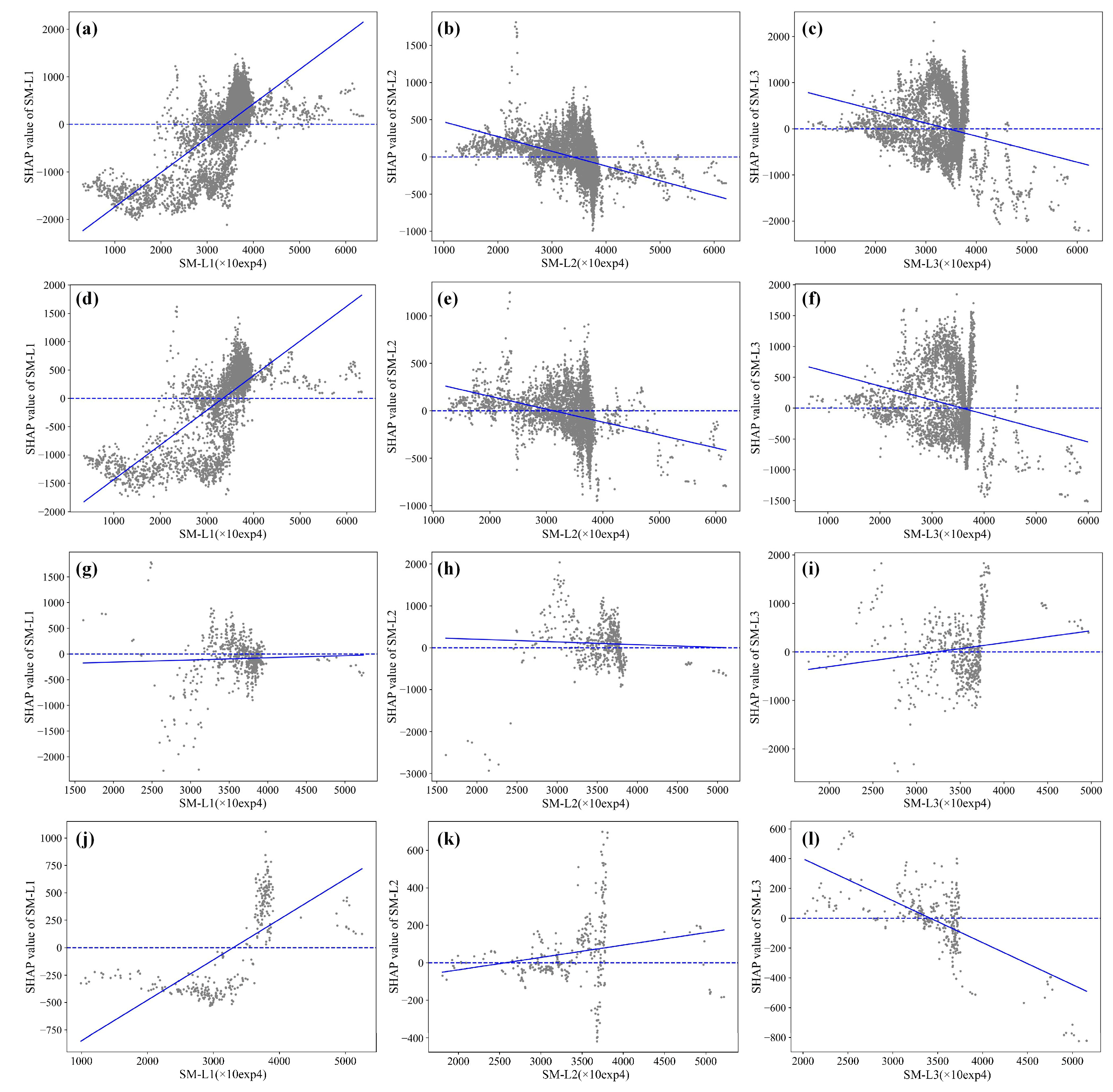
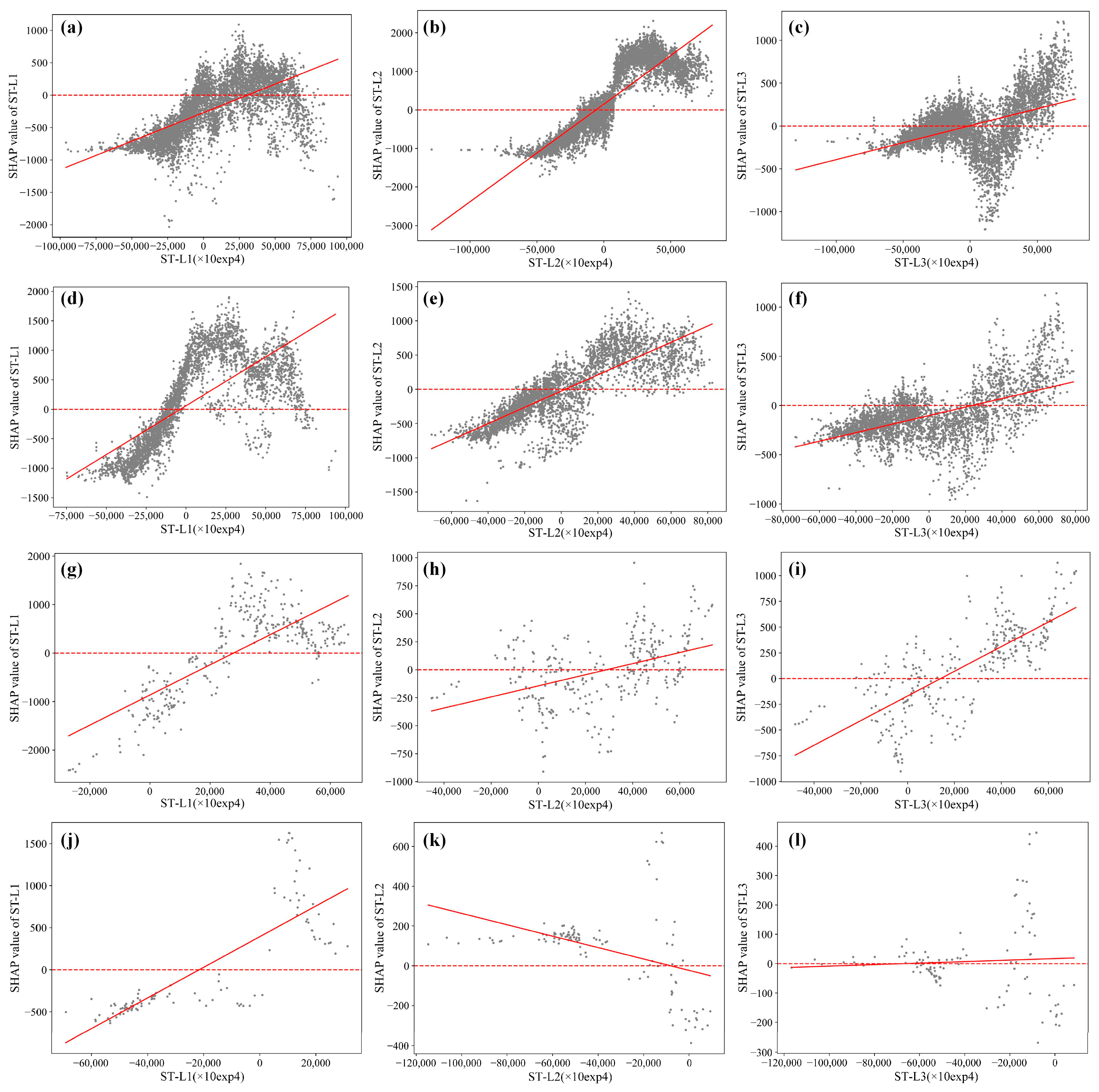
| Trend | SM-L1 | SM-L2 | SM-L3 | ST-L1 | ST-L2 | ST-L3 | GPP |
|---|---|---|---|---|---|---|---|
| Unchanged | 1.17% | 1.17% | 1.17% | 1.17% | 1.17% | 1.17% | 23.45% |
| No significant decrease | 41.13% | 35.10% | 27.72% | 5.38% | 4.69% | 3.48% | 0.75% |
| Slight significant decrease | 4.53% | 3.37% | 3.04% | 0.00% | 0.00% | 0.00% | 0.06% |
| Significant decrease | 4.27% | 2.66% | 3.30% | 0.00% | 0.00% | 0.00% | 0.07% |
| Extremely significant decrease | 0.84% | 0.71% | 0.91% | 0.00% | 0.00% | 0.00% | 0.11% |
| No significant increase | 37.89% | 35.36% | 28.04% | 60.62% | 57.62% | 55.19% | 9.02% |
| Slight significant increase | 4.73% | 9.97% | 4.99% | 12.50% | 12.87% | 14.66% | 5.32% |
| Significant increase | 3.95% | 9.07% | 7.77% | 13.54% | 16.51% | 17.59% | 15.57% |
| Extremely significant increase | 1.49% | 2.59% | 23.06% | 6.80% | 7.14% | 7.90% | 45.65% |
| Soil Hydrothermal Conditions | Soil Layer | Correlation Coefficient |
|---|---|---|
| Soil moisture | SM-L1 | 0.0945 * |
| SM-L2 | 0.3176 * | |
| SM-L3 | 0.5076 * | |
| Soil temperature | ST-L1 | 0.5566 * |
| ST-L2 | 0.5539 * | |
| ST-L3 | 0.5480 * |
| Soil Hydrothermal Conditions | Soil Layer | Grassland | Shrub | Alpine |
|---|---|---|---|---|
| Soil moisture | SM-L1 | 0.1298 | 0.0101 | −0.2480 |
| SM-L2 | 0.3420 | 0.2754 | 0.0074 | |
| SM-L3 | 0.5169 | 0.4784 | 0.3678 | |
| Soil temperature | ST-L1 | 0.5577 | 0.5539 | 0.5529 |
| ST-L2 | 0.5546 | 0.5531 | 0.5558 | |
| ST-L3 | 0.5493 | 0.5427 | 0.5487 |
Disclaimer/Publisher’s Note: The statements, opinions and data contained in all publications are solely those of the individual author(s) and contributor(s) and not of MDPI and/or the editor(s). MDPI and/or the editor(s) disclaim responsibility for any injury to people or property resulting from any ideas, methods, instructions or products referred to in the content. |
© 2023 by the authors. Licensee MDPI, Basel, Switzerland. This article is an open access article distributed under the terms and conditions of the Creative Commons Attribution (CC BY) license (https://creativecommons.org/licenses/by/4.0/).
Share and Cite
Wei, D.; Zhang, Y.; Li, Y.; Zhang, Y.; Wang, B. Hydrothermal Conditions in Deep Soil Layer Regulate the Interannual Change in Gross Primary Productivity in the Qilian Mountains Area, China. Forests 2023, 14, 2422. https://doi.org/10.3390/f14122422
Wei D, Zhang Y, Li Y, Zhang Y, Wang B. Hydrothermal Conditions in Deep Soil Layer Regulate the Interannual Change in Gross Primary Productivity in the Qilian Mountains Area, China. Forests. 2023; 14(12):2422. https://doi.org/10.3390/f14122422
Chicago/Turabian StyleWei, Di, Yang Zhang, Yiwen Li, Yun Zhang, and Bo Wang. 2023. "Hydrothermal Conditions in Deep Soil Layer Regulate the Interannual Change in Gross Primary Productivity in the Qilian Mountains Area, China" Forests 14, no. 12: 2422. https://doi.org/10.3390/f14122422
APA StyleWei, D., Zhang, Y., Li, Y., Zhang, Y., & Wang, B. (2023). Hydrothermal Conditions in Deep Soil Layer Regulate the Interannual Change in Gross Primary Productivity in the Qilian Mountains Area, China. Forests, 14(12), 2422. https://doi.org/10.3390/f14122422







